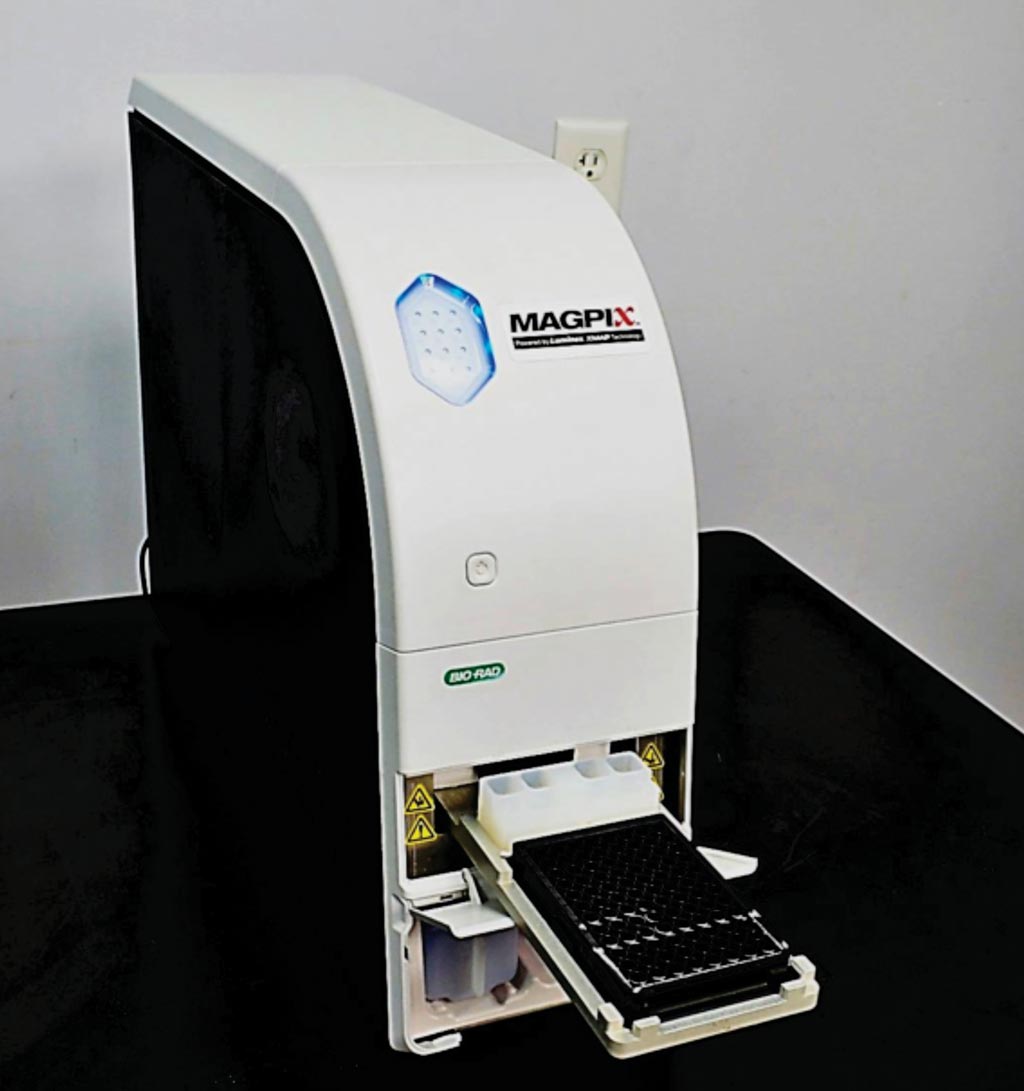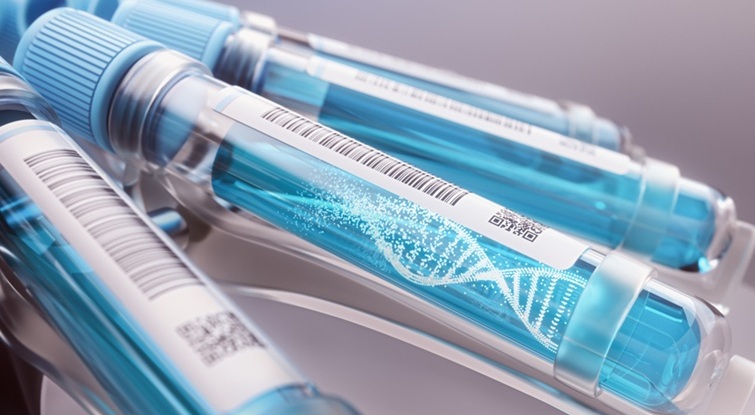Malarial Cytokine Responses Reduced by Age in Exposed Children
|
By LabMedica International staff writers Posted on 10 Jan 2018 |

Image: The MAGPIX CCD Imager, a compact multiplexing unit (Photo courtesy of Luminex).
Elevated levels of pro-inflammatory cytokines and chemokines in the peripheral blood during acute malaria infection contribute to the control of parasitemia, but are also responsible for much of the immunopathology seen during symptomatic disease.
Young children are at greatest risk for malaria-associated morbidity and mortality. The immune response of young children differs in fundamental ways from that of adults, and these differences likely contribute to the increased susceptibility of children to severe malaria and to their delayed development of immunity.
An international team of scientists working with those at University of California San Francisco (CA, USA) obtained blood samples from study cohort that was initiated in 2011 and is ongoing. This cohort consists of 100 households where malaria transmission in this region is holoendemic, with an annual entomological inoculation rate (EIR) of 310 infective bites per person year. In total, plasma samples from 48 children were analyzed: 25 from children 1 to 3 years old and 23 from children 7 to 10 years old.
Thick blood smears were stained with 2% Giemsa for 30 minutes. Thick smears were evaluated for the presence of parasitemia (asexual forms only) and gametocytes. The concentrations of 20 cytokines and chemokines were measured in plasma samples using Luminex technology. Fourteen cytokines and six chemokines were analyzed using a custom R&D Magnetic Luminex Screening Assay Human Premixed Multi-Analyte Kit and read on a Luminex MAGPIX CCD Imager. Human interferon gamma (IFNγ) OptEIA ELISA II Kits were used to quantify IFNγ levels in plasma.
The team found that younger children presenting with acute malaria exhibited much higher levels of tumor necrosis factor (TNF), interleukin-2 (IL2), and IL6, as well as increased T helper cells (Th1) associated chemokines interferon gamma-induced protein 10 (IP10), Monokine induced by gamma interferon (MIG), and monocyte chemoattractant protein-1 (MCP1), was compared to older children with acute malaria. Additionally, the regulatory cytokines IL10 and tumor necrosis factor receptor 1 (TNFRI) were dramatically elevated in younger children compared to older children during acute infection, indicating that regulatory as well as pro-inflammatory cytokine responses are dampened in later childhood.
The authors concluded that that despite age-related differences in immune responses, young children respond with a largely pro-inflammatory Th1-type cytokine and chemokine response, similar to naïve travelers; however, they also show increased levels of the regulatory cytokines IL10 and soluble TNFRI, which may limit their ability to develop robust immunity to subsequent malaria infections. The study was published on December 29, 2017, in the Malaria Journal.
Related Links:
University of California San Francisco
Young children are at greatest risk for malaria-associated morbidity and mortality. The immune response of young children differs in fundamental ways from that of adults, and these differences likely contribute to the increased susceptibility of children to severe malaria and to their delayed development of immunity.
An international team of scientists working with those at University of California San Francisco (CA, USA) obtained blood samples from study cohort that was initiated in 2011 and is ongoing. This cohort consists of 100 households where malaria transmission in this region is holoendemic, with an annual entomological inoculation rate (EIR) of 310 infective bites per person year. In total, plasma samples from 48 children were analyzed: 25 from children 1 to 3 years old and 23 from children 7 to 10 years old.
Thick blood smears were stained with 2% Giemsa for 30 minutes. Thick smears were evaluated for the presence of parasitemia (asexual forms only) and gametocytes. The concentrations of 20 cytokines and chemokines were measured in plasma samples using Luminex technology. Fourteen cytokines and six chemokines were analyzed using a custom R&D Magnetic Luminex Screening Assay Human Premixed Multi-Analyte Kit and read on a Luminex MAGPIX CCD Imager. Human interferon gamma (IFNγ) OptEIA ELISA II Kits were used to quantify IFNγ levels in plasma.
The team found that younger children presenting with acute malaria exhibited much higher levels of tumor necrosis factor (TNF), interleukin-2 (IL2), and IL6, as well as increased T helper cells (Th1) associated chemokines interferon gamma-induced protein 10 (IP10), Monokine induced by gamma interferon (MIG), and monocyte chemoattractant protein-1 (MCP1), was compared to older children with acute malaria. Additionally, the regulatory cytokines IL10 and tumor necrosis factor receptor 1 (TNFRI) were dramatically elevated in younger children compared to older children during acute infection, indicating that regulatory as well as pro-inflammatory cytokine responses are dampened in later childhood.
The authors concluded that that despite age-related differences in immune responses, young children respond with a largely pro-inflammatory Th1-type cytokine and chemokine response, similar to naïve travelers; however, they also show increased levels of the regulatory cytokines IL10 and soluble TNFRI, which may limit their ability to develop robust immunity to subsequent malaria infections. The study was published on December 29, 2017, in the Malaria Journal.
Related Links:
University of California San Francisco
Latest Microbiology News
- New UTI Diagnosis Method Delivers Antibiotic Resistance Results 24 Hours Earlier
- Breakthroughs in Microbial Analysis to Enhance Disease Prediction
- Blood-Based Diagnostic Method Could Identify Pediatric LRTIs
- Rapid Diagnostic Test Matches Gold Standard for Sepsis Detection
- Rapid POC Tuberculosis Test Provides Results Within 15 Minutes
- Rapid Assay Identifies Bloodstream Infection Pathogens Directly from Patient Samples
- Blood-Based Molecular Signatures to Enable Rapid EPTB Diagnosis
- 15-Minute Blood Test Diagnoses Life-Threatening Infections in Children
- High-Throughput Enteric Panels Detect Multiple GI Bacterial Infections from Single Stool Swab Sample
- Fast Noninvasive Bedside Test Uses Sugar Fingerprint to Detect Fungal Infections
- Rapid Sepsis Diagnostic Device to Enable Personalized Critical Care for ICU Patients
- Microfluidic Platform Assesses Neutrophil Function in Sepsis Patients
- New Diagnostic Method Confirms Sepsis Infections Earlier
- New Markers Could Predict Risk of Severe Chlamydia Infection
- Portable Spectroscopy Rapidly and Noninvasively Detects Bacterial Species in Vaginal Fluid
- CRISPR-Based Saliva Test Detects Tuberculosis Directly from Sputum
Channels
Clinical Chemistry
view channel
Compact Raman Imaging System Detects Subtle Tumor Signals
Accurate cancer diagnosis often depends on labor-intensive tissue staining and expert pathological review, which can delay results and limit access to rapid screening. These conventional methods also make... Read more
Noninvasive Blood-Glucose Monitoring to Replace Finger Pricks for Diabetics
People with diabetes often need to measure their blood glucose multiple times a day, most commonly through finger-prick blood tests or implanted sensors. These methods can be painful, inconvenient, and... Read moreMolecular Diagnostics
view channel
Urine Test Could Reveal Real Age and Life Span
Chronological age does not always reflect how quickly the body is aging, as biological age is shaped by genetics, stress, sleep, nutrition, and lifestyle factors such as smoking. A higher biological age... Read more
Genomic Test Identifies African Americans at Risk for Early Prostate Cancer Recurrence
Prostate cancer is one of the most commonly diagnosed cancers in men and a leading cause of cancer-related death, particularly in the United States. African American men face a disproportionately higher... Read moreHematology
view channel
MRD Tests Could Predict Survival in Leukemia Patients
Acute myeloid leukemia is an aggressive blood cancer that disrupts normal blood cell production and often relapses even after intensive treatment. Clinicians currently lack early, reliable markers to predict... Read more
Platelet Activity Blood Test in Middle Age Could Identify Early Alzheimer’s Risk
Early detection of Alzheimer’s disease remains one of the biggest unmet needs in neurology, particularly because the biological changes underlying the disorder begin decades before memory symptoms appear.... Read more
Microvesicles Measurement Could Detect Vascular Injury in Sickle Cell Disease Patients
Assessing disease severity in sickle cell disease (SCD) remains challenging, especially when trying to predict hemolysis, vascular injury, and risk of complications such as vaso-occlusive crises.... Read more
ADLM’s New Coagulation Testing Guidance to Improve Care for Patients on Blood Thinners
Direct oral anticoagulants (DOACs) are one of the most common types of blood thinners. Patients take them to prevent a host of complications that could arise from blood clotting, including stroke, deep... Read moreMicrobiology
view channel
New UTI Diagnosis Method Delivers Antibiotic Resistance Results 24 Hours Earlier
Urinary tract infections affect around 152 million people every year, making them one of the most common bacterial infections worldwide. In routine medical practice, diagnosis often relies on rapid urine... Read more
Breakthroughs in Microbial Analysis to Enhance Disease Prediction
Microorganisms shape human health, ecosystems, and the planet’s climate, yet identifying them and understanding how they are related remains a major scientific challenge. Even with modern DNA sequencing,... Read morePathology
view channel
Genetics and AI Improve Diagnosis of Aortic Stenosis
Aortic stenosis is a progressive narrowing of the aortic valve that restricts blood flow from the heart and can be fatal if left untreated. There are currently no medical therapies that can prevent or... Read more
AI Tool Simultaneously Identifies Genetic Mutations and Disease Type
Interpreting genetic test results remains a major challenge in modern medicine, particularly for rare and complex diseases. While existing tools can indicate whether a genetic mutation is harmful, they... Read more
Rapid Low-Cost Tests Can Prevent Child Deaths from Contaminated Medicinal Syrups
Medicinal syrups contaminated with toxic chemicals have caused the deaths of hundreds of children worldwide, exposing a critical gap in how these products are tested before reaching patients.... Read more
Tumor Signals in Saliva and Blood Enable Non-Invasive Monitoring of Head and Neck Cancer
Head and neck cancers are among the most aggressive malignancies worldwide, with nearly 900,000 new cases diagnosed each year. Monitoring these cancers for recurrence or relapse typically relies on tissue... Read moreTechnology
view channel
Pioneering Blood Test Detects Lung Cancer Using Infrared Imaging
Detecting cancer early and tracking how it responds to treatment remains a major challenge, particularly when cancer cells are present in extremely low numbers in the bloodstream. Circulating tumor cells... Read more
AI Predicts Colorectal Cancer Survival Using Clinical and Molecular Features
Colorectal cancer is one of the most common and deadly cancers worldwide, and accurately predicting patient survival remains a major clinical challenge. Traditional prognostic tools often rely on either... Read moreIndustry
view channel
BD and Penn Institute Collaborate to Advance Immunotherapy through Flow Cytometry
BD (Becton, Dickinson and Company, Franklin Lakes, NJ, USA) has entered into a strategic collaboration with the Institute for Immunology and Immune Health (I3H, Philadelphia, PA, USA) at the University... Read more




















